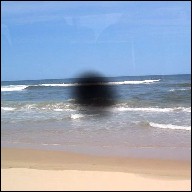Have you been lately noticing a black spot at all times, whenever you try to look at an object or a person? Chances are that you are having a vision disorder known as Scotoma. Read on to find out all about the disorder, including its various possible causes, symptoms, treatment options and more.
Scotoma Definition
Page Contents
Simply put, Scotoma refers to an obscure region in the field of vision. Many people with this condition notice a dark spot at the corner of the eye that obstructs peripheral vision. In medical world, it is defined as an island or area of impairment or loss of visual acuity circumvented by a field of normal or comparatively well-preserved vision.
The disorder is also commonly referred to as “Blind Spot.”
Scotoma Etymology
The word “Scotoma” is Greek in origin and actually stands for “darkness” in the language. In the plural form, it is known as “Scotomata” or “Scotomas.”
Scotoma ICD9 Code
The ICD9 Code for this visual condition is 368.44.
Scotoma Types
The major types of this condition are:
Central scotoma
It refers to a region of reduced or lost vision that impedes central vision. It is likely to affect the activities of daily life of patients. Those having this form of the condition may have problems in seeing details and colors. They may find difficulty in recognizing people by looking at their faces. They may also have a tough time in reading books and magazines printed in fonts of regular size. They may look from the peripheries or sides of the eye, and others may not know what they are actually looking at. Such people may see best in dim-lit regions. They may, however, be able to note things best while they are moving.
Hemianopic scotoma
It is the name given to an area of reduced or lost vision that has an adverse impact on half of the central visual field.
Peripheral scotoma
It is a region of lost or reduced vision towards the edge of the visual field. It is not likely to have as much impact on daily activities as the previous forms of the disorder. Those with these types of Scotoma may see well when looking at colors and details. They may have the best vision in well-lit regions. They may bump into objects while walking due to an inability to see them.
Pareacentral scotoma
It is an area of lost or decreased vision near the central visual field, although not actually in it.
Bilateral Scotoma
It is a type of Scotoma in which a pituitary tumor starts to compress the optic chiasm and leads to a bi-temporal hemicentral scotomatous hemianopia. Based on the symptoms, this form of defect of the visual field tends to be highly prominent. However, it often evades early diagnosis as it is harder to diagnose with the aid of cursory clinical examination rather than bi-temporal peripheral hemianopia. It may even avoid advanced electronic modes of assessment of the visual field.
It is only in rare cases that this condition is found to arise.
Scotoma Symptoms
The disorder is mainly characterized by one or more dark or light areas or even blurred regions in the visual field. People affected by loss of visual field may also suffer from an increased requirement of greater contrast and illumination while reading. They may also experience difficulties in perceiving some colors.
The retina is similar to a thin skin on the inner side of the posterior (back) region of the eye. These contain the nerves that receive light through the pupil and send it to the brain as visual messages. There are certain areas on the retina where these nerves are unable to function. The light fails to make them work. These spots are referred to as Scotomas.
In the majority of sufferers, these blind spots or dark regions are persistent. In some cases, however, the spots may be temporary and shifting in nature as is the case with the Scotomata of migraine headache. The visual fields of the left and the right eye overlap to a great extent. The visual fields may not be evident without separately testing each eye in a specific manner.
Those affected by this disorder may find it difficult to know the identity of people by looking at their faces.
Following a brain injury or stroke, a Scotoma of any size or shape may arise and can affect any part of the visual field. In some individuals, a Scotoma is likely to include and lead to the enlargement of the blind spot that naturally occurs in the eye of a person.
A pathological scotoma, or Scotoma that gives rise to symptoms, may include any section of the visual field and may be of any size or shape. A scotoma may involve and magnify the normal blind spot. A severe visual handicap may arise as a result of even a small scotoma that happens to affect the macular or central vision of sufferers. On the other hand, a big scotoma in the more peripheral section of a visual field may go undetected by a person having it.
In pregnant women, the condition can manifest itself as a sign of severe Preeclampsia which is a type of hypertension induced by pregnancy. Similarly, it can also arise due to elevated intracranial pressure that results in malignant hypertension.
Scotoma Causes
The condition may arise due to a variety of factors. This could be a result of a corrective surgical operation in the eye or an ocular infection that has left a scar in the eye. The infection could have occurred while the sufferer was still in the womb of his or her mother.
The disorder may also result from an eye problem known as Retinitis Pigmentosa, a degenerative hereditary condition of the retina that is characterized by various problems like:
- Night blindness
- Changes in pigment within the retina
- Eventual loss of vision
Some other possible causes of Scotoma include:
- Glaucoma
- Blockages in the retinal veins and especially, the optic nerve
- A stroke or a brain injury
- Side effects of high blood pressure and multiple sclerosis
- Serious vitamin deficiencies and poor nutrition
- Toxic substances, especially quinine and methyl alcohol
The condition is also found to occur along with a number if eye disorders, optic nerve disorders and other diseases.
The most common causes of Scotoma include the following:
- Nutritional deficiencies
- Demyelinating disorders, such as Multiple sclerosis (retrobulbar neuritis)
- Toxic substances, such as quinine and methyl alcohol
- Vascular obstructions, either in the optic nerve or in the retina
Scotomae that occur due to tumors or those arising from the pituitary gland are less common in nature. These may compress the optic nerve or impede the supply of blood to it. They are medically important. These are sometimes curable or reversible by operative methods.
What is a Scintillating Scotoma?
It refers to a localized region of reduced vision that is edged by shimmering colored lights. It indicates the onset of migraine in many sufferers. It is a special marker for migraine headaches. In this type of Scotoma, the dark spots may move about around the eye – creating arcs of light or zig-zag patterns. The occurrence of disturbances in the visual field can serve as warning signs to migraine sufferers about the impending headaches.
Scotoma Diagnosis
The diagnosis of this disease usually begins with a physical examination in the initial stages. Doctors examine the eyes of sufferers and also ask them questions about their symptoms. They are also asked about any other conditions or any eye surgery that they may have recently suffered or gone through.
Medical tests used for the detection of this disorder include:
- Amsler grid
- Perimetry
- Visual field test
- Horizontal eccentricity
Scotoma Differential Diagnosis
The differential diagnosis of this disease involves ensuring that the symptoms experienced by sufferers are those of Scotoma and not of similar conditions of the eye. These may include:
- Glaucoma
- Optic Neuritis
- Retinitis
- Vascular disorders
- Retinal degeneration
- Carotid Artery Thrombosis
- Optic Atrophy
- Ophthalmodynamometry
Scotoma Treatment
Once the condition has been diagnosed and its underlying cause has been determined, physicians develop a proper treatment option. In some cases, treatment helps the spot – assuming that there has not been a permanent damage to the eye. In other cases, Scotoma persists. However, it is vital to manage the underlying cause and to prevent further damage to the eye.
Earlier, only a few measures could be used to cure Scotoma. However, advanced research in neuroplasticity and the ability of the brain to develop and heal throughout adulthood has led to effective means rehabilitation of vision.
Some individuals find that eye exercises help them cope with the condition. Eye exercises help them use their eyes in abnormal ways to compensate for the loss of vision. Some companies also manufacture and promote vision treatment systems that can supposedly cure the symptoms of Scotoma. However, the credibility of such companies and their products have not yet been properly evaluated and established.
In the majority of cases, Scotoma cannot be cured. However, it is still important to seek treatment from an ophthalmologist in the event of occurrence of Scotoma as it can suggest an acute problem.
Scotoma Prevention
Proper medical treatment can be used to prevent the enlargement of the dark spot in the eye and address the underlying cause of development of Scotoma.
Scotoma Pictures
The following images will help you get an idea about the vision of Scotoma sufferers.
Picture 1 – Scotoma
Picture 2 – Scotoma Image
If you suspect yourself to be exhibiting the symptoms of Scotoma, get in touch with an ophthalmologist at the earliest. Seeking optical care on an immediate basis can help you recover from the condition and its symptoms as early as possible. In the long run, it can safeguard the health of your eyes – two of your most vital sensory organs.
References:
http://en.wikipedia.org/wiki/Scotoma
http://www.britannica.com/EBchecked/topic/529529/scotoma
http://www.wisegeek.com/what-is-scotoma.htm
http://www.csb-cde.ca.gov/Documents/Causes%20of%20Visual%20Impairment/causes_scotomas.htm


